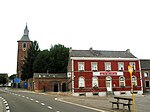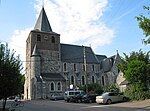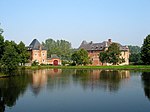Burdinne
Liège geography stubsMunicipalities of Liège ProvincePages with French IPA

Burdinne (French pronunciation: [byʁdin]; Walloon: Beurdene) is a municipality of Wallonia located in the province of liège, Belgium. On 1 January 2006 Burdinne had a total population of 2,824. The total area is 32.57 km2 which gives a population density of 87 inhabitants per km2. The municipality consists of the following districts: Burdinne, Hannêche, Lamontzée, Marneffe, Oteppe, and Vissoul.
Excerpt from the Wikipedia article Burdinne (License: CC BY-SA 3.0, Authors, Images).Burdinne
Rue Neuve,
Geographical coordinates (GPS) Address Nearby Places Show on map
Geographical coordinates (GPS)
| Latitude | Longitude |
|---|---|
| N 50.583333333333 ° | E 5.0666666666667 ° |
Address
Rue Neuve 1
4210
Liège, Belgium
Open on Google Maps







